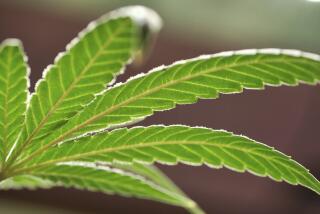Clinton Unveils Policy to Fight Illicit Narcotics
- Share via
MIAMI — Escalating the election-year skirmish over crime, President Clinton on Monday unveiled what he called “a new and intensified strategy to battle drugs” while Republicans in Washington sharpened their fire at his record on combating illegal narcotics.
In a speech to middle-school students and community leaders here, Clinton disclosed a new anti-drug policy highlighted by proposals to crack down on methamphetamine, a highly addictive stimulant whose use has been rising, particularly in California and elsewhere in the Southwest.
“That is a deadly drug,” Clinton said. “It’s gaining in popularity. . . . We have to stop it before it becomes the crack of the 1990s.”
In Washington, Republicans accused Clinton of slighting the drug problem during his first three years in office.
“Finally, the president ends his silence on the drug problem,” said Sen. Paul Coverdell (R-Ga.). “It’s long overdue. For three long years, the president stood mute, as illegal drugs ravaged our schools, neighborhoods and communities.”
The GOP press conference continued a steady drumbeat of Republican criticism meant to raise doubts about Clinton’s record on crime. On Monday, the Florida Republican Party welcomed Clinton to Florida with a full-page ad in the Miami Herald assailing his nomination of local attorney Charles “Bud” Stack, a leading Democratic fund-raiser, to a federal appeals court.
Sen. Bob Dole of Kansas, the presumptive GOP presidential nominee, last week termed Stack unqualified for the court and called on Clinton to withdraw his nomination.
*
Clinton’s drug plan listed five goals, beginning with encouraging “young people to reject drugs.” He also called for strengthening efforts at prevention and treatment; stiffening interdiction programs, and intensifying attempts to “break up the sources of supply” both at home and abroad.
The Clinton drug policy formally released Monday largely recycled proposals he has made before. It reiterated the call in his 1997 budget for $15.1 billion in federal drug spending, an increase of about 9% over the amount budgeted for this year. About two-thirds of the money is devoted to law enforcement and other measures to reduce the supply of drugs and about one-third targeted toward treatment and prevention.
“What is striking, is how little policy has changed at the federal level,” said Peter Reuter, a drug policy expert at the University of Maryland.
Sen. Orrin G. Hatch (R-Utah), chairman of the Judiciary Committee, welcomed the Clinton initiative, but he and other Republicans called it too little, too late.
Still, Hatch said, congressional Republicans “will provide Gen. [Barry] McCaffrey [the federal drug policy coordinator] all that he needs to get the job done.”
“President Clinton has been AWOL--absent without leadership--on the drug issue, although things seem to be picking up in this election year,” Hatch said.
The GOP rhetoric clearly revealed the Republicans’ belief that they enjoy the upper hand when it comes to the war on drugs, especially given that many administration officials, from Clinton and Vice President Al Gore down, have admitted to youthful experimentation with drugs.
The major new departure in the Clinton plan was the intensified focus on methamphetamine, a drug whose use has been spreading from California and the Southwest into the South and Midwest. Clinton proposed additional regulatory controls of chemicals used in “cooking” methamphetamine, and additional funding for investigating and prosecuting crimes related to the drug. Clinton also urged new mandatory minimum sentences that would establish penalties for the sale of methamphetamine equivalent to those now imposed for crack cocaine.
After Clinton’s speech, McCaffrey told reporters “there is no magic solution in the drug issue.” The plan should be viewed as a “10-year program” that would not eliminate the problem overnight, but with persistence could produce significant results, he said.
“There is no reason why we can’t return America to a 1960s level, pre-Vietnam era level of drug use,” McCaffrey said.
But Republicans charge that under Clinton, drug use trends have been moving in the wrong direction. And, in fact, Clinton’s own drug strategy report offers some evidence for their charges.
The report points out that the total number of regular drug users is now half as large as in 1979 and the number of hard-core users has remained stable in recent years. But it acknowledges that drug use has steadily increased among young people in the 1990s.
After delivering his speech to enthusiastic squeals from students squeezed into bleachers at the George Washington Carver Middle-School on a warm, cloudy morning, Clinton spent the afternoon playing golf in a foursome that included Hugh and Tony Rodham, the brothers of First Lady Hillary Rodham Clinton.
Later in the day, Clinton held a series of meetings that underscored the political stakes in Florida--a state that White House aides now believe Clinton can seriously contest in November, even though Republicans have dominated it in presidential elections since 1968.
Clinton met privately with the families of the pilots from a Cuban exile group shot down over Cuban airspace in February and later spoke at two Democratic National Committee fund-raising events expected to raise more than $3 million.
Times staff writer Edwin Chen in Washington contributed to this story.
More to Read
Sign up for Essential California
The most important California stories and recommendations in your inbox every morning.
You may occasionally receive promotional content from the Los Angeles Times.










